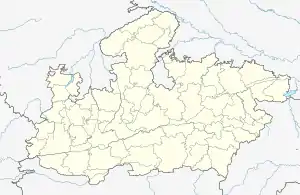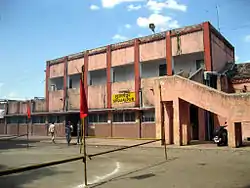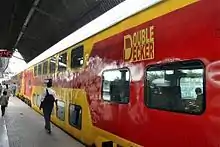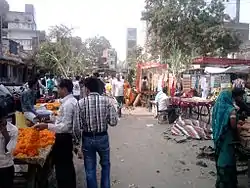Shujalpur
Shujalpur is a city and a municipality in Shajapur district in the Indian state of Madhya Pradesh. Ranoji Rao Shinde, father of Mahadji Shinde (Scindia), died in 1745 at Shujalpur, where his cenotaph (chattri) stands which houses a Shiv temple. It is known as Ranoganj.
Shujalpur
Shoojahwulpoor | |
|---|---|
city | |
 Shujalpur Location in Madhya Pradesh, India  Shujalpur Shujalpur (India) | |
| Coordinates: 23.4°N 76.72°E | |
| Country | |
| State | Madhya Pradesh |
| District | Shajapur |
| Elevation | 448 m (1,470 ft) |
| Population (2013) | |
| • Total | 35,000 |
| Languages | |
| • Official | Hindi, Malvi |
| Time zone | UTC+5:30 (IST) |
| ISO 3166 code | IN-MP |
| Vehicle registration | MP 42 |
Geography
Shujalpur is located at 23.4°N 76.72°E It has an average elevation of 448 metres (1,469 feet). The city falls in the Malwa region. Two rivers, the Nevaj and the Jamdad, flow through the city.
Railways

Shujalpur lies on the Ujjain-Sehore-Bhopal Branch Line. There are regular trains plying to Delhi, Kolkata, Chennai, Ahmedabad, Bangalore, Jaipur, Kanpur, Patna, Trivendrum, Coimbatore, Cochin, Nagpur, Jammu, Puri, Allahabad and other major cities.

Now the railway station is very beautiful july 2019
Demographics
As of 2011 India census,[1] Shujalpur had a population of 71,225. Males constitute 52% of the population and females 48%. Shujalpur has an average literacy rate of 69%, higher than the national average of 59.5%: male literacy is 76%, and female literacy is 61%. In Shujalpur, 16% of the population is under 6 years of age. People speak Malvi (a local dialect of Hindi) and Hindi. Shujalpur is a legislative assembly constituency and a tehsil .
History
The city also has a rich political history. First Prime-Minister (as then it was called) of Madhya Bharat the late Pandit Liladhar Joshi belonged to this city. The city is also known for its temple of Shiva known as Jatashankar. Every year, on the occasion of Maha shivratri, a fair is organised near the cenotaph of ranoji rao sindhia and in the Jatashankar temple.

Culture and economy
It is surrounded by more than fifty villages, which are connected via roads. Water supply of the city is mainly dependent on three dams. Jatashankar dam (built on river Jamdhad), Nandasura dam (built on river Nevaj) and Bamanghat dam (built on river Jamdhad). The city has one Government PG College named JNS (Jawaharlal Nehru Smriti).
References
- "Census of India 2001: Data from the 2001 Census, including cities, villages and towns (Provisional)". Census Commission of India. Archived from the original on 16 June 2004. Retrieved 1 November 2008.
- Sadhna Sharma (1995). States Politics in India. Mittal Publications. ISBN 978-81-7099-619-4.
